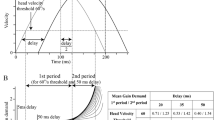Abstract
To determine age-related changes, the initial linear vestibulo-ocular reflex (LVOR) of eight older subjects of mean age 65±7 years (mean ± SD, range 56–75 years) was compared with that of nine younger subjects of mean age 24±5 years (range 18–31 years) in response to random transients of whole-body heave (interaural) translation at peak acceleration of 0.5g delivered by a pneumatic actuator. Binocular eye rotations were measured with magnetic search coils, while linear head position and acceleration were measured with a potentiometer and piezoelectric accelerometer. Subjects viewed targets 200 cm, 50 cm, or 15 cm distant immediately before the unpredictable onset of randomly directed translation in darkness (LVOR) and in light (LVVOR). All subjects maintained ideal vergence of 1.5–2° for the 200-cm target, 6–8° for the 50-cm target, and 21–26° for the 15-cm target, with actual vergences depending on individual interpupillary distances. Search coil recording of angular position of the upper teeth showed head rotation to be negligible (less than 0.5°) for the first 250 ms after onset of head translation, excluding a role for the angular VOR in the responses studied. The LVOR response to heave translation was an oppositely directed eye rotation occurring after a mean latency of 62±3 ms for older and 42±3 ms (mean ± SD) for younger subjects (P<0.0001). The peak of the latency distribution was 60–100 ms for older and 20–60 ms for younger subjects. During the early interval, 70–80 ms from head motion onset prior to a pursuit contribution or saccades, all subjects had significantly enhanced LVOR with decreasing target distance. In this interval, the LVOR position amplitude of younger subjects was 0.17±0.01°, 0.40±0.01°, 0.57±0.01° (mean ± SE), respectively, in descending order of target distance. Early sensitivities were significantly reduced for older subjects to 0.07±0.01°, 0.23±0.01°, 0.40±0.01° (P<0.0001). There was no significant effect of target visibility in either group during the first 110 ms (P>0.05). Visual-otolith interaction was mainly reflected not by the vestibular slow phase, but by vestibular catch-up saccades (VCUS) in the compensatory direction. The effect of aging on the initial human LVOR is thus to: prolong latency, reduce early sensitivity, and reduce occurrence of vestibular catch-up saccades.
Similar content being viewed by others
Author information
Authors and Affiliations
Corresponding author
Rights and permissions
About this article
Cite this article
Tian, JR., Crane, B.T., Wiest, G. et al. Effect of aging on the human initial interaural linear vestibulo-ocular reflex. Exp Brain Res 145, 142–149 (2002). https://doi.org/10.1007/s00221-002-1111-z
Received:
Accepted:
Published:
Issue Date:
DOI: https://doi.org/10.1007/s00221-002-1111-z




